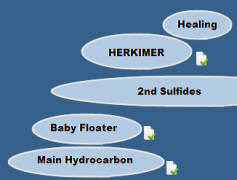Best Website for Herkimer Diamond Information
Free Website Where Herkimer Diamond Enthusiasts Share Information with the Public
Remember to refresh your browser
Dr.C. did two talks at the Herkimer Diamond Festival (July)which are in a Youtube movie. The research on the Herkimer District is in need of samples and photos.
How can you help? Visit the "how to help" page.
The General Mineral Sequence for the Herkimer Mining District
Across the region in New York that hosts "Herkimer Diamonds" several different minerals can be found. These minerals formed from fluids that entered the rock and the crystals grew out of those fluids.
The fluids left behind "clues" in the rock about their behavior. These clues can be found through a careful examination of all the minerals in relation to each other. A history of these fluid events helps us to understand how Herkimer Diamond deposits were formed. It also helps us to understand why one deposit is slightly different from another. Specific diagrams (which are estimations) for each mine are located on that mine's web page.
The diagram below is an approximation of the regional events.
This theory about the general mineral sequence occuring in the Herkimer mining district, with all the supportive documentation on this website, is not published elsewhere. Please reference the author, date (top of the page), and this website.
Notes for the Above General Mineral Sequence
The General Mineral Sequence for the Herkimer Mining District*, NY
*Click on Directions at the top of the page for a map
The above mineral sequence diagram represents the most common mineral sequence for the entire Herkimer diamond mine district. It should be considered as an "average" representation. It is also "a work in progress" because we do not have examples of every mineral in relation to every other mineral (yet). Some notes for the various mineral phases are given below:
First dolomite: This is likely the phase that changed the rock from limestone to dolostone. The crystals are small rhombs and are the most common feature at every Herkimer deposit. When unaltered they are clear or a light beige. The common form can be weathered, rounded, or altered to a tan or light brown.
Second dolomite: This is the "large dolomite" that occurs in some cavities in every deposit. When fresh it is shiny white, sometimes in saddle form. The common form is weathered or altered to a tan or beige.
Third dolomite: This also "large dolomite" that occurs in some cavities in every deposit, and it can also be tan from weathering, but inside it will be often be black, not white, or pale tan. It can also weather to a peach or even brick red color. The black dolomite is seldom seen in its unaltered state. It may sometimes be found as pink - but it appears to occur as a strong saddle form.
Early druze: This white druze, pyramidal, often forms the base for the later druze episodes. It is characterized by having a rock contact "rind" that is a clearly visible, often with microsopic laminations. Various forms of this may occur, such as "Snowball druze".
Late druze: This is the most common druze in the district and it doesn't form a thick rock contact, but it has a thin contact "rind". This druze is generally clear to smoky, pyramidal (little mountains). Often it has black inclusions (except at HH).
Early Hydrocarbon: There appears to be an early hydrocarbon event that overlaps with both the late druze and the prismatic quartz events. Its intensity varies across the district giving rise to different features. This hydrocarbon phase is responsible for "black druze" and probably black prismatic crystals.
Prismatic Phase: This phase includes both a druze and larger crystals. It seems to occur in every Herkimer mine the district, but it has a large variation from mine to mine. It frequently has black inclusions, and sometimes a brown film over phantoms. It can also show zonation on cross-section or have a Herkimer diamond growth over the top, making a scepter. This prismatic druze does occur interwined with the Baby floater druze at Ace of Diamonds where the earlier druze is absent. This reults in a unique looking druze. As with the Baby floater druze there is almost no contact rind. Some times this phase alters the previous quartz phases and may include hydrothermal alteration (like at the TCR location) that leaches the host rock turning it into a very light rock that is only a skeleton of quartz veins.
Baby floater druze: This is a coating of small to microscopic Herkimer diamonds. It has almost no contact "rind" with the host rock. This druze is probably more common in the district than has been realized previously, but weathering has made it hard to find. It is found over the top of, and mixed in with, the late prismatic druze. It is also found as inclusions in Herkimer diamonds, sometimes with "melted" edges. The fact that it is absent in some larger crystal pockets may be due to weathering, as these tiny crystals are found in the "screened mud" of most pockets. It is likely that there is a close association of this baby floater phase with the formation of Herkimer diamonds.
Hydrocarbon/Clay: There is a major hydrocarbon event that is in place before the Herkimer diamond event. The amount of associated white/pale yellow clay (not brown mud) varies across the district. The intensity of this event varies across a single deposit, but it is consided to be one of the critical events in forming the Herkimer diamond crystals.
Second sulphides: These are basically marcasite (iron and sulphur). Despite the intense weathering that turns these into rust, they are frequently preserved inside first phase calcite crystals as needle sprays. Where the weathing is not severe (and people have not scrubbed them away) they can be found coating second and third phase dolomite. They can also occur inside Herkimer diamonds.
Early Sulfides: This phase is often of very small pyrite, marcasite and chalcopyrite. This author has seen "ruby" sphalerite from HDM and HBQ. Galena has been reported from the district. It appears that the sphalerite event occured prior to other sulfides. Because of heavy weathering throughout the district these minerals are often weathered to ochre, resulting is a rust coating over near by minerals. This rust coating is different than original mineral features that impart a similar color. Blue coating from the weathering of the chalocpyrite has also been seen (at TCR and HBQ).
Herkimer Diamonds: The more this research project unfolds the more we discover that there are subtle variations in the crystal habits of Herkimer diamonds across the district. What has been common knowledge is that there is a wide range of shape, clarity, size, intergrowth growth patterns and skeletal features. But as you will see on this website the diversity is surprising, and more research is need to help explain this diversity.
First calcite: This is the most common calcite in the district. The difficulty is that the typical "nailhead" (disk shapped with 3 face on the top of the disk) form can be modified. Only part of the disk may appear, looking at just the edge of the crystal. It can be elongated out from the middle of the crystal, making a fatter disc, and sometimes it can be stretched making elongated prismatic crystals. First calcite as rhombs seems to be more rare for the district. Scalenohedrons are very rare.
Second calcite: This calcite is easy to recognize once you have seen how different it is in from from the first phase calcite. It occurs as small clusters and fans of crystals ranging from white to amber. It can also occur as a coating on top of first phase calcite.
Third calcite: This is not easy to recognize until you see it for the first time. It occurs a rounded bumps and it can be as a coating over any earlier mineral. Weathered it is very pitted, nearly unrecognizable.
There is a final weathering event that has, in some places, severely altered the minerals listed above. There is not a photo page for this (yet).
Important Note:
The minerals listed in the above sequence occur in zones, or layers. For a discussion of this see the
Mineral Zones web page.
Quartz Healing: This is an event that occurs in some isolated places within most mines. Broken Herkimers diamonds will show evidence of having been "healed", the surface shows new growth. We can also see this sometimes on the faces of crystals as a frosted etching. It is the final quatz event in the district.
The paleokarst, and sabkha, event did have an effect on the host rock. Other than changing the porosity (holes in the rock) it is not clear if any mineral crystalization can be tied to this event.
W. David Hoisington, Ph.D.
To see photos of minerals click the mineral name in the oval
Fluid cool down before continual temp. rise up to Herkimer Diamond event











